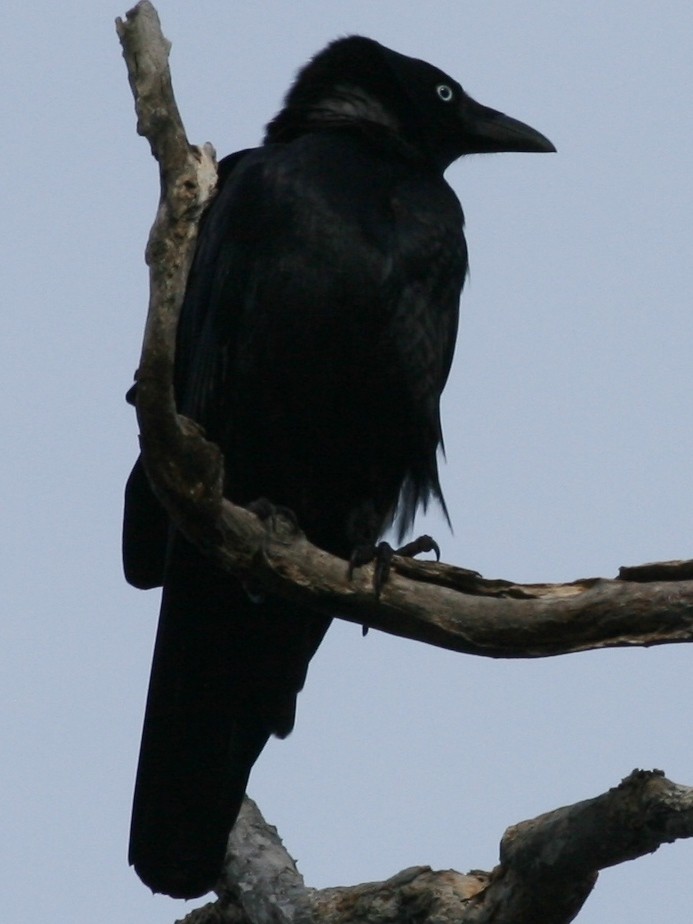Torresian Crow
A species of Crows Scientific name : Corvus orru Genus : Crows
Torresian Crow, A species of Crows
Botanical name: Corvus orru
Genus: Crows
Content
Description General Info
Description
The Torresian crow is a large corvid, about the same size (48–53 cm in length) as the Eurasian carrion crow but with a more robust bill and slightly longer legs. The plumage of the Torresian Crow is glossy black on the back and dull black on the breast with inconspicuous throat hackles. Its tail is broad and has a distinctive square-shaped tip. Its bill is dark grey and about the same length as the head. The legs and feet are a similar dark grey color with pink foot soles. The Torresian crow has the typical white iris of the other Australasian Corvus species with a fine, blue eye-ring. However, it can be distinguished from most except the little crow by the base of the head and neck feathers being white. The white feather bases are revealed when ruffled. Birds of this species characteristically shuffle their wings after alighting. Sexes are identical in their appearance; however, juveniles lack glossy dorsal feathers and have brown eyes, rather than white, up to about nine months of age. The Torresian crow is not to be confused with the Australian raven which has an almost identical appearance. Despite their visual similarities, the Australian raven and crow have very different and unique calls. 
Size
53 cm
Nest Placement
Tree
Feeding Habits
Torresian Crow are omnivorous, ingesting invertebrates, berries, carrion, fish, roadkill, fruits, grain, and small vertebrates. They display adaptability by safely consuming toxic cane toads, a learned behavior. Their foraging varies by habitat, with urban torresian Crow utilizing anthropogenic sources.
Habitat
The torresian Crow occupies diverse environments ranging from tropical rainforests to urban areas. Adapted to both natural and modified landscapes, they are commonly found in woodlands, scrublands, and coastal regions, often near water bodies. Geographically, their habitat extends to montane and lowland terrains up to 1500m elevation and includes arid zones with wooded watercourses.
Dite type
Omnivorous
General Info
Feeding Habits
Bird food type
Behavior
Like other corvids, Torresian crows are intelligent and adaptable and have been known to steal food from larger birds by working in teams, and to feed on poisonous prey without ingesting poison (see below) among other behaviours. Torresian crows are large and aggressive birds, with females displaying the more aggressive behaviour and dominating most other species except large birds of prey and the Australian magpie. They have been observed to attack larger birds of prey, particularly wedge-tailed eagles and most owl species in defence of their nest or territory. Smaller birds will therefore attack crows in defence of their nests, with willie wagtails and pied butcherbirds being notable examples. Noisy miners and Australian magpies are among the few birds that are successful in driving Torresian crows out of their territories, with the latter species being one of the smaller bird species that dominate and displace crows where they meet. Between the months of January and August, large groups of crows congregate and roam nomadically across farmlands, forests and city suburbs. These groups consist of crows of all ages; however, from September to December, many leave these flocks to breed in temporary territories, with the nomadic flock sizes reducing significantly to only young and old crows. Each pair of crows returns to the same territory each year, but territories may be taken over by other pairs from year to year. 
Distribution Area
The Torresian crow has an extensive distribution across Australia, Papua New Guinea in particular the Bismarck Archipelago and some islands in Indonesia, in particular the Moluccas. The range of the mainland Australian race C. orru ceciliae extends from the tropical north of Australia to as far south as Forster on the east coast of New South Wales and to between Geraldton and Norseman in South Western Australia. The Torresian crow occupies almost any habitat within its geographic range where there is a permanent source of water. The species is common in habitats such as tropical rainforests, eucalyptus woodland, open scrub, beaches, swamps, offshore islands. The Torresian crow is also well adapted to fringe habitats including farmland, towns and cities. On farms in much of Northern Australia, they are the most numerous bird species and are considered a pest by farmers, as they damage crops such as sweetcorn, peanuts, wheat and many kinds of fruit. Torresian crows are common in urban landscapes and many cities and towns in Australia support large populations. In the arid zones of central Australia, the species is sparsely distributed and confined to areas with permanent water. Two other races occur on various islands to the north: C. orru orru in Papua New Guinea and the Moluccas), and C. orru latirostris on Tanimbar and Babar Islands. 
Species Status
Not globally threatened.
Scientific Classification
Phylum
Chordates Class
Birds Order
Perching birds Family
Crows and jays Genus
Crows Species
Torresian Crow 